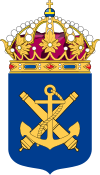Visby marina bevakningsområde
| Visby marina bevakningsområde (BoVi) | |
| Information | |
|---|---|
| Officiellt namn | Visby marina bevakningsområde |
| Datum | 1957–1958 |
| Land | Sverige |
| Försvarsgren | Marinen |
| Typ | Bevakningsområde |
| Roll | Sjöbevakning |
| Del av | Marinkommando Ost [a] |
| Storlek | Stab |
| Högkvarter | Visby garnison |
| Förläggningsort | Visby |
| Övningsplats | Visby hamn |
| Tjänstetecken | |
| Sveriges örlogsflagga |  |
Visby marina bevakningsområde (BoVi) var ett sjöbevakningsförband inom svenska marinen som verkade åren 1957–1958. Förbandsledningen var förlagd i Visby garnison i Visby.[1]
Historik
Visby marina bevakningsområde bildades i samband med att Gotlands marindistrikt upplöstes den 12 december 1956.[2] År 1958 upplöstes bevakningsområdet och dess uppgift övertogs av Gotlands kustartilleriförsvar med Gotlands kustartillerikår (GK/KA 3). Förbandsledningen var förlagd till Visby.
Namn, beteckning och förläggningsort
|
|
Se även
Referenser
Anmärkningar
- ^ Åren 1957–1957 var förbandet underställt chefen för Ostkustens marindistrikt, åren 1957–1958 chefen för Marinkommando Ost.
Noter
- ^ Birke, Braunstein (2011), s. 52-53
- ^ ”Gotlands marindistrikt”. tjelvar.se. Arkiverad från originalet den 18 augusti 2018. https://web.archive.org/web/20180818052237/http://www.tjelvar.se/marinen/marinen.htm. Läst 17 augusti 2018.
Tryckta källor
- Birke, Sune; Braunstein, Christian (2011). Sveriges marina förband och skolor under 1900-talet. Skrift / Statens försvarshistoriska museer, 1101-7023 ; 13. Stockholm: Statens försvarshistoriska museer. sid. 19-20. Libris 12638815
| |||||||||||||||||||||||||||||||||||||||||||||||||||||||||||||||||||||||||||||||||||||||||||||||||
Media som används på denna webbplats
Författare/Upphovsman: User: David Newton, Licens: CC BY-SA 3.0
Swedish war flag and naval ensign
Adoption: Dates back to the mid-1600s. Described in law on November 6, 1663. Current design: June 22, 1906
Författare/Upphovsman: Koyos
, Licens: CC BY-SA 3.0
See about CoA blazoning: [Expand]
Författare/Upphovsman:
- Försvarets_krigsspelscentrum_vapen.svg: Lokal_Profil
- derivative work: Edaen (talk)
See about CoA blazoning: [Expand]
The Flag of Europe is the flag and emblem of the European Union (EU) and Council of Europe (CoE). It consists of a circle of 12 golden (yellow) stars on a blue background. It was created in 1955 by the CoE and adopted by the EU, then the European Communities, in the 1980s.
The CoE and EU are distinct in membership and nature. The CoE is a 47-member international organisation dealing with human rights and rule of law, while the EU is a quasi-federal union of 27 states focused on economic integration and political cooperation. Today, the flag is mostly associated with the latter.
It was the intention of the CoE that the flag should come to represent Europe as a whole, and since its adoption the membership of the CoE covers nearly the entire continent. This is why the EU adopted the same flag. The flag has been used to represent Europe in sporting events and as a pro-democracy banner outside the Union.









